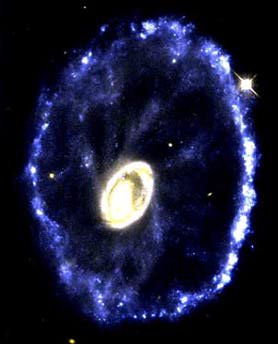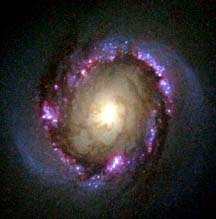Not all stars in spiral galaxies and barred galaxies are ejected by the poles of the galactic core. Smaller, more harmonic electromagnetic fields over the rest of the core induce smaller stars. These stars are repelled from the core in all directions. They are smaller, more stable stars. They create the bulge of a spiral galaxy -- and most of the stars in elliptical galaxies. This process is, in general, the complete description of spherical and elliptical galaxies.
Graphic of core inducing stars -- big stars from the poles, small stars in all directions.
Of course, the core of a spiral galaxy has a spin and this is what creates the spiral. Some galactic cores do not spin. The cores in these galaxies spew out huge balls-of-light that later explode in the outer lobes of Radio Galaxies.
Graphic of spinning garden sprinkler.
A spinning galaxy, ejecting stars off its poles, and smaller stars in all directions is analogous to the classic garden sprinkler. The stars ejected from the poles are like the large water drops squirted from the arms of the sprinkler -- they travel further. The stars ejected from other areas of the core are like the smaller drops (the mist) squirted from the central stem of the sprinkler -- and they travel shorter distances.
It has long been known that the colors of stars vary in a spiral galaxy. The Ball-of-Light Particle Model predicts that the massive ejected stars are blue. These stars have very little of envelope material around them. The Ball-of-Light Particle Model predicts the bulge stars have less mass and are inherently more harmonic because they are ejected by less energetic waves on the galactic core. They survive long, do not tend to explode, and develop thick plasma envelopes, thus tending to be red. The zones of instability in galaxies have a variety of stars because big, massive blue stars are exploding creating a myriad of short-term, reds, blues and whites -- and, of course, the large clouds of gas, ionized gas, and dust from the recent decays.
Thus, the Ball-of-Light Particle Model not only predicts the general relationship of the variation of star colors in galaxies -- how they vary from red to blue -- it also predicts the observed exceptions.
In general, galaxies start out small and blue, and end up large and red. This is shown, very crudely, by the following QuickTime animation that I have created using an HST image of M100.
What happens, over long periods, to the stability of the galactic cores? In general, or maybe I should say, on the average, the cores become more stable. However, some cores can go through intense periods of instability, ejecting rings of stars, while others may explode.

The Cartwheel galaxy is an example of a core that is undergoing periods of greater and lesser instability. Long ago during a period of great instability, it ejected its outer ring. Then, it went through a more stable phase. Relatively recently, it ejected a second ring. Some of the ejected balls-of-light in the inner ring are truly massive. Note how the large blue stars are decaying more as the outer ring slows down and becomes more unstable due to gravitational attraction to the core. For more info, see Cartwheel Galaxy.
The Cartwheel galaxy is not a fluke. The following example is of a galaxy going through a similar phase.
Barred galaxies often are mixed with spirals. The Ball-of-Light Particle Model predicts that the cores of galaxies can go through phases of greater and lesser instability. For example, a galactic core may initially start off in a fairly unstable stage creating a spiral galaxy, then go through a very unstable phase where it ejects stars in a bar, then goes through an extremely unstable phase where it ejects stars in a ring, then settles down once again into a spiral galaxy.
Here is an example of just such a galaxy.

(This image is only the very central region of a much larger barred galaxy with a very thin outer spiral.) This galaxy has gone through the following stages:
The core of this galaxy was ejected by a larger ball-of-light.
Note how the inner spiral arms are more twisted. This indicates that the instability that created the ring propelled the core into a faster spin as the large stars were ejected from the core. For more info, see ?? Galaxy.